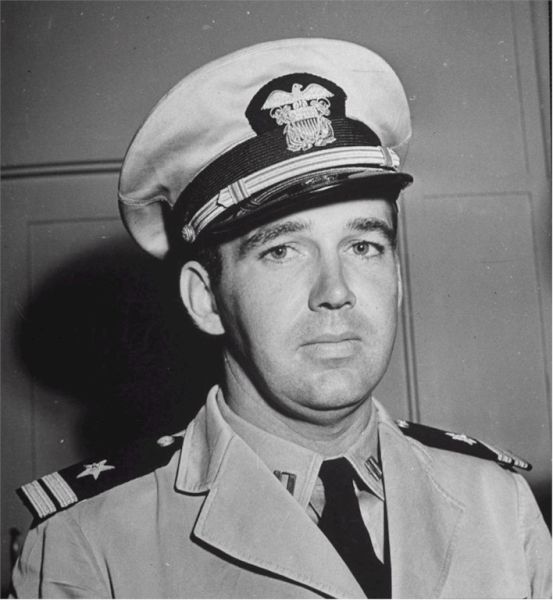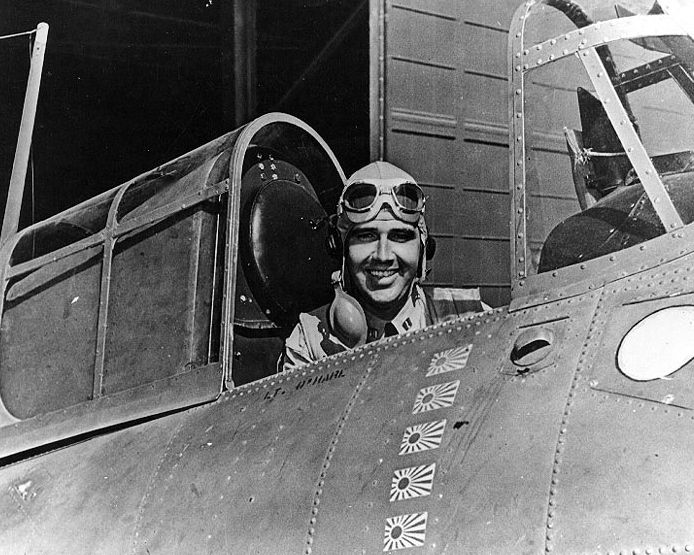O'Hare, Edward Henry "Butch"
- Date of birth:
- March 13th, 1914 (St.Louis/Minnesota, United States)
- Date of death:
- November 26th, 1943 (Tarawa, Pacific)
- Service number:
- 0-078672
- Nationality:
- American (1776 - present, Republic)
Biography
Promotions:
June 1937: Ensign;
1941: Lieutenant (junior grade);
?: Lieutenant;
April 1942: Lieutenant Commander
Career:
June 1937: U.S.S. New Mexico (BB-40);
May 1940: Fighter Squadron 3 (VF-3), U.S.S. Saratoga (CV-3);
1942: Fighter Squadron 3 (VF-3), U.S.S. Lexington (CV-2);
June 1942: Commanding Officer Fighting Squadron 3 (VF-3);
1943: Commanding Officer Fighting Squadron 6 (VF-6), U.S.S. Independence (CVL-22);
November 1943: Commannding Officer Air Group 6, U.S.S. Enterprise (CV-6)
Do you have more information about this person? Inform us!
- Period:
- Second World War (1939-1945)
- Rank:
- Lieutenant
- Unit:
- Navy Fighting Squadron 3 (VF-3), U.S.S. Lexington (CV-2), U.S. Navy
- Awarded on:
- 1942
As a result of his gallant action--one of the most daring, if not the most daring, single action in the history of combat aviation--he undoubtedly saved his carrier from serious damage."
- Period:
- Second World War (1939-1945)
- Rank:
- Lieutenant Commander
- Unit:
- Fighting Squadron 2 (VF-2), U.S.S. Enterprise (CV-6), U.S. Navy
- Awarded on:
- August 1944
"For extraordinary heroism in operations against the enemy while serving as Pilot of a carrier-based Navy Fighter Plane in Fighting Squadron TWO (VF-2), embarked from the U.S.S. ENTERPRISE (CV-6), and deployed over Tarawa in the Gilbert Islands, in action against enemy Japanese forces on 26 November 1943. When warnings were received of the approach of a large force of Japanese torpedo bombers, Lieutenant Commander O'Hare volunteered to lead a fighter section of aircraft from his carrier, the first time such a mission had been attempted at night, in order to intercept the attackers. He fearlessly led his three-plane group into combat against a large formation of hostile aircraft and assisted in shooting down two Japanese airplanes and dispersed the remainder. Lieutenant Commander O'Hare's outstanding courage, daring airmanship and devotion to duty were in keeping with the highest traditions of the United States Naval Service. He gallantly gave his life for his country."
Awarded posthumously.
Bureau of Naval Personnel Information Bulletin No. 329 (August 1944).
Awarded posthumously.
Bureau of Naval Personnel Information Bulletin No. 329 (August 1944).
- Period:
- Second World War (1939-1945)
- Rank:
- Lieutenant Commander
- Period:
- Second World War (1939-1945)
- Rank:
- Lieutenant Commander
- Unit:
- Fighting Squadron 6 (VF-6), U.S. Navy
Second DFC received in the form of a golden star to be worn on the ribbon of the first DFC.
- Period:
- Second World War (1939-1945)
- Period:
- Second World War (1939-1945)
- Period:
- Second World War (1939-1945)
- Period:
- Second World War (1939-1945)
- Period:
- Second World War (1939-1945)
Sources
- Photo 1: Bill Gonyo
- - JORDAN, K. N., SR., Yesterday's Heroes, Schiffer Publishing Ltd., Atglen, United States, 1996.
- Sterner C.D., Recipients of The Navy Cross, 1916 - Present
- Home of Heroes
- Naval Historical Center
- Find a Grave
- Butch O'Hare: The Forgotten History of the First Naval Recipient of the Medal of Honor During WWII












